Շամախցի • Shamakhtsi | |
|---|---|
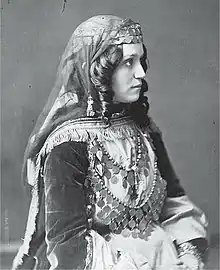 Armenian woman from Shamakhi in the 19th century | |
| Regions with significant populations | |
| Shamakhi, Mədrəsə, Şirvan | |
| Languages | |
| Armenian, Tat Iranian, Azerbaijani | |
| Religion | |
| Christianity (mostly Armenian Apostolic and Protestant) and Islam (mostly Shia) | |
| Related ethnic groups | |
| Armenians in Azerbaijan |
Armenians have had a longstanding historical presence in the Shamakhi District (Armenian: Շամախի). From the 16th century up until the 18th century, Armenians formed the majority population of the capital, Shamakhi.[1][2] Armenians retained a significant presence in the Shamakhi district until the First Nagorno-Karabakh war, which resulted in the forced displacement of the remaining unassimilated Shamakhi Armenians to Armenia.[3]
History
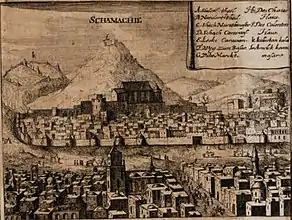
On the origins of the Shamakhi Armenians, Miller quotes bishop Mesrop Smbatian in stating that at least some groups of them were eighteenth-century migrants from Karabakh.[4] Armenians of Kilvar claimed descent from mediaeval migrants from Edessa (present-day Şanlıurfa, Turkey).[5] Miller concluded that Armenians of Madrasa may have been early migrants from the Absheron Peninsula where the presence of a Christian community was historically attested. Archaeologist Vladimir Sysoyev, who visited Shamakhi in 1925 and described ruins of a mediaeval Armenian church, held interviews with local residents who dated the first settlement of Armenians in Shamakhi and its vicinities to the late sixteenth or early seventeenth century.[6]
In 1562 Englishman Anthony Jenkinson described the city of Shamakhi in the following terms: "This city is five days' walk on camels from the sea, now it has fallen a lot; it is predominantly populated by Armenians..."[7][8] Adam Olearius, who visited Shamakhi in 1637, wrote: "Its inhabitants are in part Armenians and Georgians, who have their particular language; they would not understand each other if they did not use Turkish, which is common to all and very familiar in Shirvan".[9] In the mid-1700s, the population of Shamakhi was about 60,000, most of whom were Armenians.[10]
The British Penny Cyclopaedia stated in 1833 that "The bulk of the population of Shirvan consists of the Tartar, or, to speak more correctly, Turkish race, with some admixture of Arabs and Persians. . . . Besides the Mohammedans, who form the mass of the population, there are many Armenians, some Jews, and a few Gypsies. According to the official returns of 1831, the number of males belonging to the Mohammedan population was 62,934; Armenians, 6,375; Jews, 332; total males 69,641. The prevalent language of Shirvan is what is there called Toorkee or Turkish, which is also used in Azerbaijan". The same source also states that according to the official returns of 1832, the city of Shamakhi was inhabited by only 2,233 families, as a result of devastation from the sack of the city "in the most barbarous manner by the highlanders of Daghestan" in 1717.[11] The Encyclopædia Britannica stated that in 1873 the city had 25,087 inhabitants, "of which 18,680 were Tartars (later known as Azerbaijanis), and Shachsevans, 5,177 were Armenians, and 1,230 Russians".
In 1918, there were 15 villages with a homogeneous Armenian population in the area surrounding Shamakhi: Matrasa, Meisari, Qarqanj, Qalakhan, Arpavut, Khanishen, Dara-Qarqanj, Mirishen, Zarkhu, Saghian, Pakhraqush, Giurjilar, Ghajar, Tvarishen and Balishen.[12]
In the beginnings of the First Nagorno-Karabakh war, the Armenians of Shamakhi found themselves in a hostile situation. During the late 1980s and early 1990s, the Armenian populated villages of the Shamakhi district underwent a forced village exchange with Azerbaijani populated villages of Armenia. The remaining Armenians of Shamakhi were forcefully displaced from their homes.[13]
Culture
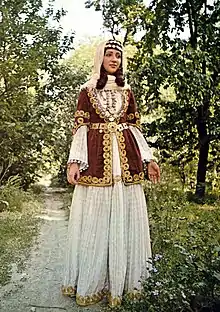
Textiles
Silk production was the main output of Shamakhi and a significant part of the cultural heritage of Armenians with 130 silk-winding establishments, owned mostly by Armenians, although the industry considerably declined since 1864.[14]
Shamakhi was also one of the centers of Armenian carpet making. The Shamakhi carpet style was known for its unique dragon motifs. The Armenian dragon carpet, known natively as the vishapagorg, was one of the most popular carpet styles throughout the caucasus and an important representation of Armenian cultural heritage.[15]
Shamakhi dancers
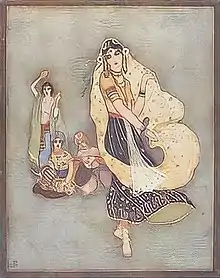
Shamakhi was known for its unique Shamakhi dancers. This art form was enjoyed by Armenians and Azerbaijanis alike. Armenian dancers like Armen Ohanian had great contributions to the art form. The Dancer of Shamakha recounts the life of Armenian dancer Armen Ohanian, her education as a dancer, her childhood in Russia, and her travels in Iran and Egypt. It was published in French as La Danseuse de Shamakha in 1918 and translated into English in 1923 by Rose Wilder. After moving to Europe, Ohanian danced traditional dances for audiences, gave lectures on poetry, and was an active member in intellectual and political circles.[16]
Religion
According to the Brockhaus and Efron Encyclopedic Dictionary (vol. 77, p. 460, published in 1903), Shamakhi had 20,008 inhabitants (10,450 males and 9,558 females), of which 79% of the population was Muslim, of which 22% was Sunni and the rest Shiite; the remaining 21% was "Armeno-Gregorian" (members of the Armenian Apostolic Church) and "Pravoslav" (Orthodox).[17] Shamakhi also had a significant Armenian Protestant community that was often in conflict with the Armenian Apostolic Church.[18]
Olearius, Bakikhanov and Miller noted a high rate of assimilation among Shirvan Armenians, with some adopting Muslim faith and diffusing in the majority (this went on well into the eighteenth century) and others shifting to the Tat language, while remaining Christian.[6]
Armeno-Tats
Armeno-Tats are a distinct group of Tat-speaking Armenians that historically populated eastern parts of the South Caucasus especially in the Shamakhi district. Most scholars researching the Tat language, such as Boris Miller and Igrar Aliyev, agree that Armeno-Tats are ethnic Armenians who underwent a language shift and adopted Tat as their first language.[19] This is explained on one hand by the self-identification of Armeno-Tats who stated during Miller's research that they consider themselves Armenian as well as by some linguistic features of their dialect.[4]
Language
Adam Olearius travelled through the historical region of Shirvan (present-day central Azerbaijan) in 1637 and mentioned the existence of a community of Armenians in the city of Shamakhi, who "had its own language" but also "spoke Turkic, as did all people in Shirvan".[20]
Shamakhi dialect

The Shamakhi dialect of Armenian, similar to the Karabakh dialect, was a significant part of the cultural heritage of Shamakhi Armenians. It was well-preserved when Armenians lived in Shamakhi due to their minority status, but fell out of use following the forced relocation of Armenians in 1988.[3]
Notable natives
- Armen Ohanian - Armenian dancer, actress, writer and translator
- Hovhannes Abelian - actor
- Alexander Shirvanzade - playwright and novelist, awarded by the "People's Writer of Armenia" and "People's Writer of Azerbaijan" titles
- Gostan Zarian - Armenian writer and poet
Gallery
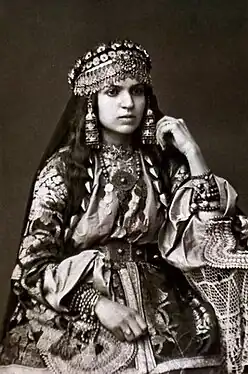 Armenian woman from Shamakhi, by D. E. Yermakov, 1870s
Armenian woman from Shamakhi, by D. E. Yermakov, 1870s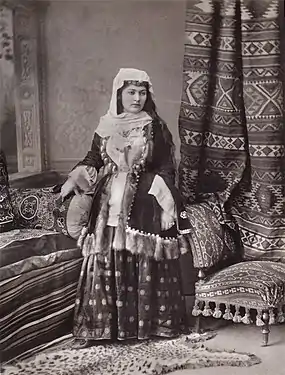 Noble Armenian woman from Shamakhi in the 19th century
Noble Armenian woman from Shamakhi in the 19th century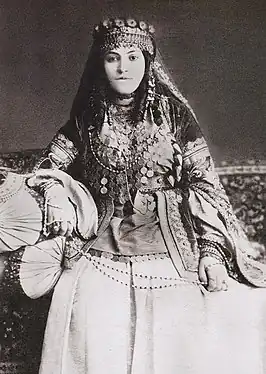 Photo of the traditional dress of Armenian girl in Shamakhi in the late 19th century by F. Orden
Photo of the traditional dress of Armenian girl in Shamakhi in the late 19th century by F. Orden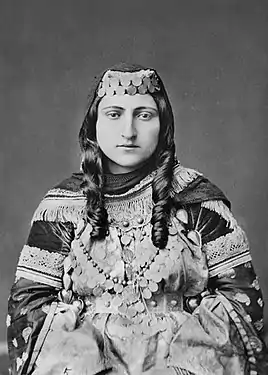 Armenian woman from Shamakhi, 1883
Armenian woman from Shamakhi, 1883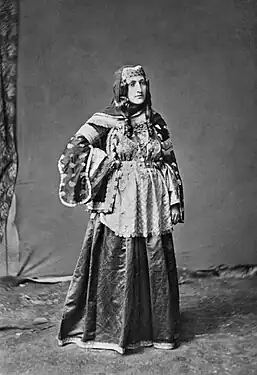 Armenian woman from Shamakha (nowadays in Azerbaijan). 1883
Armenian woman from Shamakha (nowadays in Azerbaijan). 1883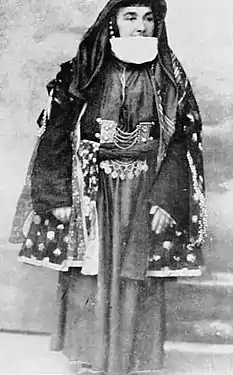 Armenian lady from Shamakhi
Armenian lady from Shamakhi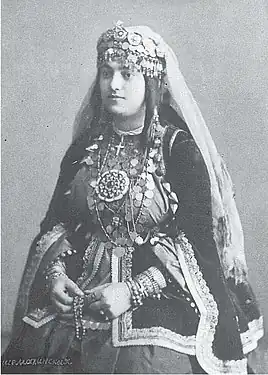 Armenian woman from Shamakhi
Armenian woman from Shamakhi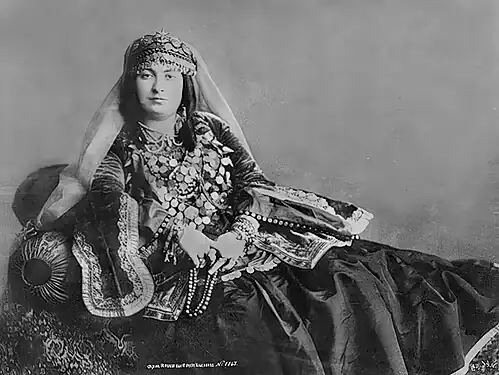 Armenian woman from Shamakhi, Photo by F. Orden 1897
Armenian woman from Shamakhi, Photo by F. Orden 1897
See also
References
- ↑ Dorfmann-Lazarev, Igor (2023). "The Udis' Petition to Tsar Peter". In Gippert, Josh; Dum-Tragut, Jasmine (eds.). Caucasian Albania: An International Handbook. Germany: De Gruyter. p. 262. doi:10.1515/9783110794687-006. ISBN 9783110794687.
It was planned to facilitate the Russian troops in their progression to Shamakhi, a city with an Armenian majority
- ↑ Karapetyan, Samvel (1997). "Shamakhi". The Armenian Lapidary Inscriptions of Boon-Aghvank (in Armenian). Vol. 1. "Gitutiun" Publishing House of NAS RA. p. 54. ISBN 5-8080-0144-7.
- 1 2 Narine Vlasyan (February 5, 2019). "Shamakhi: A Lost Dialect, a Lost Identity". evnreport.com.
- 1 2 Boris Miller. Tats: Their Settlement and Dialects. Azerbaijan Research and Study Society. Baku, 1929.
- ↑ Artem Dvinov. Stavropol Krai Armenians Marking 210th Anniversary of Edissia Archived 2015-04-19 at the Wayback Machine. Kavkazsky Uzel. 2 September 2007. Retrieved 15 July 2012.
- 1 2 S. Guchman. Story of Three Shamakhi Icons; p. 113
- ↑ Извѣстiя Англичанъ о Россiи во второй половинѣ XVI вѣка. Переводъ съ Англiйскаго, съ предисловiемъ С. М. Середонина, p. 63
- ↑ Richard Hakluyt (1972). Voyages and Discoveries (2nd ed.). London: Penguin Books Limited. pp. 91–101. ISBN 978-0-14-043073-8.
- ↑ Adam Olearius (1666). Relation du voyage de Adam Olearius en Moscovie, Tartarie et Perse... Vol. 1. Paris: traduit de l'allemand par A. de Wicquefort. pp. 405–406.
- ↑ "Shamaki, reckoned the capital of this province, stands on a river which falls into the Caspian sea, and is about sixty-six miles from Derbent towards the south, and ninety-two from Gangea to the south-east. This city was one of the best and most populous of Persia, before it was destroyed by an earthquake. It is, however, supposed to contain near 60,000 inhabitants, chiefly Armenians and strangers, whom the pleasantness of the country and traffic have invited thither" (An Universal History: From the Earliest Accounts to the Present Time, by George Sale, George Psalmanazar, Archibald Bower, George Shelvocke, John Campbell, John Swinton, vol. 43, London, 1765, p. 138)
- ↑ The Penny Cyclopædia of the Society for the Diffusion of Useful Knowledge, vol. XI, London, 1833, pp. 174–175.
- ↑ Karapetian, S (1997). Armenian Lapidary Inscriptions of Boon-Aghvank. Yerevan: Publishing House of the State Academy of Sciences of Armenia “Gitut'yun”. p. 46. ISBN 5-8080-0144-7.
- ↑ Sevil Huseynova, Arsen Hakobyan, Sergey Rumyantsev (2008). BEYOND THE KARABAKH CONFLICT: The Story of Village Exchange (PDF). Heinrich Boell Foundation South Caucasus Regional Office. ISBN 978-9941050435.
{{cite book}}: CS1 maint: multiple names: authors list (link) - ↑ The Encyclopædia Britannica, vol. 21, Philadelphia, 1894, p. 831, article "Shirvan".
- ↑ Siamak Rahimi, Meysam Sadeghpour & Asghar Panahzadeh (April 22, 2018). "Investigation on Meaning of Dragon Motif Designed on Rugs in Aran and Armenia (South Caucasus)". Journal of Basic and Applied Scientific Research Jbasr. Tehran: Department of Art, Payam noor University. ISSN 2090-4304.
- ↑ Ohanian, Armen (1918). La Danseuse de Shamakha (Foreword by Anatole France). Paris: Bernard Grasset. OL 24549255M.
- ↑ Brockhaus and Efron Encyclopedic Dictionary. Shemakha
- ↑ Ambartsumov, Ivan (2018). "Armenian Protestantism and the Religious Crisis in Shamakhi (1840s–1860s): Toward the Question of Russian Imperial Confessionalism". State Religion and Church in Russia and Worldwide. Gosudarstvo, religiia, tserkov' v Rossii i za rubezhom 36(1). 36: 229–252. doi:10.22394/2073-7203-2018-36-1-229-252.
- ↑ Southwestern Iranian languages.
- ↑ Adam Olearius. Travels of the Ambassadors sent by Frederic, Duke of Holstein, to the Great Duke of Muscovy and the King of Persia. Book IV. Chapter 20.
.jpg.webp)